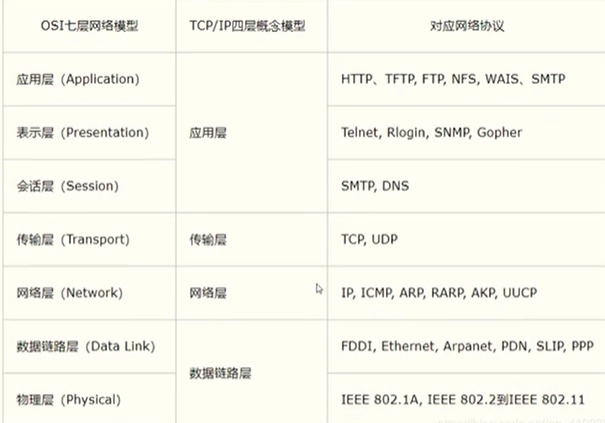网络编程
1.1概述
地球村
计算机网络:
计算机网络是指将地理位置不同的具有独立功能的多台计算机及其外部设备,通过通信线路连接起来,在网络操作系统,网络管理软件及网络通信协议的管理和协调下,实现资源共享和信息传递的计算机系统。
网络编程的目的:
无线电台…传播交流信息,数据交换。通信
想要达到这个效果需要什么:
1.如何准确的定位网络上的一台主机 192.168.16.124:端口,定位到这个计算机上的某个资源
2.找到了这个主机,如何传输数据呢?
javaweb:网页编程 B/S
网络编程 :TCP/IP C/S
1.2网络通信的要素
通信双方地址:
IP
端口号
规则:网络通信的协议
TCP/IP参考模型

小结:
1.网络编程中有两个主要的问题
如何准确的定位到网络上的一台或多台主机
找到主机之后如何进行通信
2.网络编程中的要素
IP和端口号:ip
网络通信协议:udp tcp
3.万物皆对象
1.3 IP
ip地址:InetAdress
唯一定位一台网络计算机
127.0.0.1:本机localhost
ip地址的分类
ipv4/ipv6
ipv4 127.0.0.1,4个字节组成,0-255 ,42亿;30一在北美,亚洲4亿,2011年就用尽
ipv6:128为,8个无符号整数
公网(互联网)-私网(局域网)
ABCD类地址
192.168.xx.xx,专门给组织内部使用的
域名:记忆IP问题
package com.kuang.lesson07;
import java.net.InetAddress;
import java.net.UnknownHostException;
//测试IP
public class TestInetAddress {
public static void main(String[] args) {
try {
//查询本机地址
InetAddress inetAddress1 = InetAddress.getByName("127.0.0.1");
System.out.println(inetAddress1);
InetAddress inetAddress3 = InetAddress.getByName("localhost");
System.out.println(inetAddress3);
InetAddress inetAddress4 = InetAddress.getLocalHost();
System.out.println(inetAddress4);
//查询网站ip地址
InetAddress inetAddress2 = InetAddress.getByName("www.baidu.com");
System.out.println(inetAddress2);
//常用方法
System.out.println(inetAddress2.getAddress());
System.out.println(inetAddress2.getCanonicalHostName());//规范的名字
System.out.println(inetAddress2.getHostAddress());//ip
System.out.println(inetAddress2.getHostName());//域名,或者自己电脑的名字
} catch (UnknownHostException e) {
e.printStackTrace();
}
}
}
1.4端口
端口表示计算机上的一个程序的进程:
不同的进程有不同的端口号!用来区分软件!
被规定0-65535
被分为TCP,UDP:65535*2 单个协议下,端口号不能冲突
端口分类:
公有端口0-1023
HTTP:80
HTTPS:443
FTP:21
Telent:23
程序注册端口:1024~49151,分配用户或者程序
Tomcat:8080
MySQL:3306
Oracle:1521
动态、私有:49152~65535
netstat -ano#(查看所有的端口)
netstat -ano|findstr "53400"#查看制定的端口
tasklist|findstr "9984"#查看指定端口的进程
Ctrl + shift + ESC#查看任务管理器快捷键
package com.kuang.lesson07;
import java.net.InetSocketAddress;
public class TestInetSocketAddress {
public static void main(String[] args) {
InetSocketAddress socketAddress = new InetSocketAddress("127.0.0.1", 8080);
InetSocketAddress socketAddress2 = new InetSocketAddress("localhost", 8080);
System.out.println(socketAddress);
System.out.println(socketAddress2);
System.out.println(socketAddress.getAddress());
System.out.println(socketAddress.getHostName() );//地址
System.out.println(socketAddress.getPort());//端口
}
}
1.5通信协议
协议:约定,就好比我们现在说的普通话
网络通信协议: 速率、传输码率、代码结构、传输控制
大事化小:分层
TCP/IP协议簇:实际上是一组协议
重要:
TCP:用户传输协议
UDP:用户数据报协议
出名的协议:
TCP:
IP:网络互连协议
TCP UDP对比:
TCP:打电话
连接,wend
三次握手 四次挥手
客户端、服务端
传输完成,释放连接,效率低
UDP: 发送短信
不连接,不稳定
客户端、服务端:没有明确的界限
不管有没有准备好,都可以发给你
导弹
DDOS:洪水攻击!(饱和攻击)
1.6 TCP
客户端
1.连接服务器Socket
2.发送消息
虽然代码没有出错 但是没有输出结果 不知道错在哪
package com.kuang.lesson08;
import java.io.IOException;
import java.io.OutputStream;
import java.net.InetAddress;
import java.net.Socket;
import java.net.UnknownHostException;
//客户端
public class TcpClientDemo01 {
public static void main(String[] args) {
Socket socket = null;
OutputStream os = null;
try {
//1.要知道服务器的地址
InetAddress serverIP = InetAddress.getByName("127.0.0.1");
int port = 9999;
//2.创建一个socket连接
socket = new Socket(serverIP,port);
//3.发送消息,要用到IO流
os = socket.getOutputStream();
os.write("你好,欢迎学习狂神说java".getBytes());
}catch (Exception e){
e.printStackTrace();
}finally {
if (os!=null){
try{
os.close();
}catch(IOException e){
e.printStackTrace();
}
}
if (socket!=null){
try{
socket.close();
}catch (IOException e){
e.printStackTrace();
}
}
}
}
}
服务器
1.建立服务的端口ServerSocket
2.等待用户的链接 accept
3.接收用的消息
package com.kuang.lesson08;
import java.io.ByteArrayOutputStream;
import java.io.IOException;
import java.io.InputStream;
import java.net.ServerSocket;
import java.net.Socket;
//服务端
public class TcpServerDemo01 {
public static void main(String[] args) {
ServerSocket serverSocket = null;
Socket socket = null;
InputStream is = null;
ByteArrayOutputStream baos = null;
try {
//1.我得有一个地址
serverSocket = new ServerSocket(9999);
//2.等待客户端连接过来
while(true){
socket = serverSocket.accept();
//3.读取客户端的消息
is = socket.getInputStream();
//管道流
baos = new ByteArrayOutputStream();
byte[] buffer = new byte[1024];
int len;
while ((len = is.read(buffer))!=-1){
baos.write(buffer,0,len);
}
System.out.println(baos.toString());}
/*
byte[] buffer = new byte[1024];
int len;
while((len = is.read(buffer))!=-1){
String msg = new String(buffer,0,len);
System.out.println(msg);
}*/
}catch (IOException e){
e.printStackTrace();
}finally {
//关闭资源
if(baos != null){
try{
baos.close();
}catch (IOException e){
e.printStackTrace();
}
}
if(is!=null){
try{
is.close();
}catch (IOException e ){
e.printStackTrace();
}
}
if (socket!=null){
try{
socket.close();
}catch (IOException e){
e.printStackTrace();
}
}
if (serverSocket!=null){
try{
serverSocket.close();
}catch (IOException e){
e.printStackTrace();
}
}
}
}
}
文件上传
客户端:
package com.kuang.lesson08;
import java.io.*;
import java.net.InetAddress;
import java.net.Socket;
import java.net.UnknownHostException;
public class TcpClientDemo02 {
public static void main(String[] args) throws Exception {
//1.创建一个Socket连接
Socket socket = new Socket(InetAddress.getByName("127.0.0.1"),9000);
//2.创建一个输出流
OutputStream os = socket.getOutputStream();
//3.读取文件
FileInputStream fis = new FileInputStream(new File("1.jpg"));
//4.写出文件
byte[] buffer = new byte[1024];
int len;
while ((len= fis.read(buffer))!=-1){
os.write(buffer,0,len);
}
//通知服务器,我已经结束
socket.shutdownOutput();//我已经传输完了
//确定服务器接收完毕,才能够断开连接
InputStream inputStream = socket.getInputStream();
//String byte[]
ByteArrayOutputStream baos = new ByteArrayOutputStream();
byte[] buffer2 = new byte[1024];
int len2;
while ((len2=inputStream.read(buffer2))!=-1){
baos.write(buffer2,0,len2);
}
System.out.println(baos.toString());
//5.关闭资源
baos.close();
inputStream.close();
fis.close();
os.close();
socket.close();
}
}
服务器端:
```java
package com.kuang.lesson08;
import java.io.*;
import java.net.ServerSocket;
import java.net.Socket;
public class TcpServerDemo02 {
public static void main(String[] args) throws IOException {
//1.创建服务
ServerSocket serverSocket = new ServerSocket(9000);
//2.监听客户端的连接
Socket socket = serverSocket.accept();//阻塞式监听,会一直等待客户端连接
//3.获取输入流
InputStream is = socket.getInputStream();
//4.文件输出
FileOutputStream fos = new FileOutputStream(new File("receive.jpg"));
byte[] buffer = new byte[1024];
int len;
while((len=is.read(buffer))!=-1){
fos.write(buffer,0,len);
}
//通知客户端我接收完毕
OutputStream os =socket.getOutputStream();
os.write("我接收完毕,可以断开".getBytes());
//关闭资源
fos.close();
is.close();
socket.close();
serverSocket.close();
}
}
```
Tomcat
服务端
自定义S
Tomcat服务器S
客户端
自定义C
浏览器B
1.7UDP
发短信:不用链接,需要知道对方的地址(代码没有显示出错 但是没有输出结果)
发送消息
package com.kuang.lessom09;
//不需要连接服务器
import java.io.IOException;
import java.net.*;
import java.nio.charset.StandardCharsets;
public class UdpClientDemo01 {
public static void main(String[] args) throws Exception {
//1.建立一个Socket
DatagramSocket socket = new DatagramSocket();
//2.建个包
String msg = "你好啊,服务器!";
//发送给谁
InetAddress localhost = InetAddress.getByName("localhost");
int port = 9001;
//数据,数据的长度起始,要发送给谁
DatagramPacket packet = new DatagramPacket(msg.getBytes(),0,msg.getBytes().length,localhost,port);
//3 发送包
socket.send(packet);
//4.关闭流
socket.close();
}
}
接收端:
package com.kuang.lessom09;
import java.io.IOException;
import java.net.DatagramPacket;
import java.net.DatagramSocket;
import java.net.SocketException;
//还是要等待客户端的链接
public class UdpServerDemo01 {
public static void main(String[] args) throws Exception {
//开放端口
DatagramSocket socket = new DatagramSocket(9001);
//接收数据
byte[] buffer = new byte[1024];
DatagramPacket packet = new DatagramPacket(buffer, 0, buffer.length);//接收
socket.receive(packet);//阻塞接收
System.out.println(packet.getAddress().getHostAddress());
System.out.println(new String(packet.getData(),0, packet.getLength()));
//关闭链接
socket.close();
}
}
循环发送消息
package com.kuang.chat;
import java.io.IOException;
import java.net.DatagramPacket;
import java.net.DatagramSocket;
import java.net.SocketException;
public class UdpReceiverDemo01 {
public static void main(String[] args) throws Exception {
DatagramSocket socket = new DatagramSocket(6666);
while (true) {
//准备接收包裹
byte[] container = new byte[1024];
DatagramPacket packet = new DatagramPacket(container, 0, container.length);
socket.receive(packet);//阻塞式接收包裹
//断开链接 bye
byte[] data = packet.getData();
String receiveData = new String(data,0,data.length);
System.out.println(receiveData);
if (receiveData.equals("bye")){
break;
}
}
socket.close();
}
}
package com.kuang.chat;
import java.io.BufferedReader;
import java.io.InputStreamReader;
import java.net.DatagramPacket;
import java.net.DatagramSocket;
import java.net.InetSocketAddress;
import java.net.SocketException;
public class UpSenderDemo01 {
public static void main(String[] args) throws Exception {
DatagramSocket socket = new DatagramSocket(8888);
//准备数据:控制台读取System.in
BufferedReader reader = new BufferedReader(new InputStreamReader(System.in));
while(true) {
String data = reader.readLine();
byte[] datas = data.getBytes();
DatagramPacket packet = new DatagramPacket(datas, 0, datas.length, new InetSocketAddress("localhost", 6666));
socket.send(packet);
if (data.equals("bye")){
break;
}
}
socket.close();
}
}